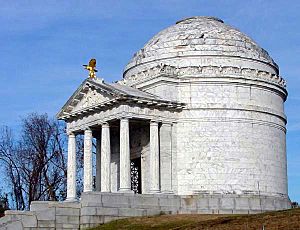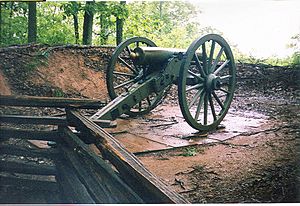National Military Park facts for kids


National Military Parks and National Battlefields are special places in the United States. These are historic sites where important battles took place. The U.S. government protects these areas because they are very important to the nation's history. They show us where armed conflicts happened that helped shape the country we live in today.
There are 25 such sites across the United States. They have different names like National Military Park, National Battlefield, National Battlefield Park, and National Battlefield Site. Even though they have different names, the National Park Service manages and protects all of them in the same way.
Contents
Why These Sites Matter
These protected battle sites teach us about different wars in American history. Most of them, 17 sites, are from the American Civil War. This was a war fought within the United States between 1861 and 1865. Four sites are from the American Revolutionary War, when the U.S. fought for its independence from Great Britain. One site is from the War of 1812, and another from the French and Indian War. Two sites also mark places where conflicts with Native Americans occurred.
How These Parks Began
The very first site like this was Chickamauga and Chattanooga National Military Park. It was created by the U.S. Congress in 1890. For many years, the War Department (which is now called the Department of Defense) took care of these battlefields.
However, on August 10, 1933, all these sites were moved to the care of the National Park Service. This agency is part of the U.S. government and is in charge of protecting and preserving national parks and historic places.
Different Names, Same Goal
The different names for these sites, like "park" or "site," often depended on how Congress felt when they first created them. Sometimes, "park" was used for larger battle areas. For example, Brices Cross Roads National Battlefield Site is a smaller area and still has that name. Other sites that were once called "sites" have since been renamed to "parks."
Some battlefields are also protected under different names. These include National Monuments like Little Bighorn Battlefield National Monument, or National Historical Parks such as Harpers Ferry National Historical Park. No matter the name, the main goal is to preserve these important places for future generations.
Protecting Our History
All these battle sites are considered historic areas within the National Park System. This means they are automatically listed on the National Register of Historic Places. This list helps to identify and protect important historic places across the country. By preserving these battlefields, we can remember the past and learn from the events that shaped our nation.

